

Subject verb agreement – Google Drive. Prepositions of Time - at, in, on. We use: at for a PRECISE TIMEin for MONTHS, YEARS, CENTURIES and LONG PERIODSon for DAYS and DATES Look at these examples: I have a meeting at 9am.The shop closes at midnight.Jane went home at lunchtime.In England, it often snows in December.Do you think we will go to Jupiter in the future?
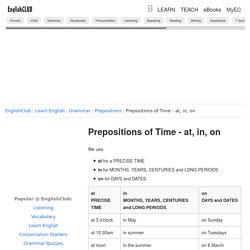
There should be a lot of progress in the next century.Do you work on Mondays? Her birthday is on 20 November.Where will you be on New Year's Day? Notice the use of the preposition of time at in the following standard expressions: *Note that in some varieties of English people say "on the weekend" and "on Christmas". Notice the use of the prepositions of time in and on in these common expressions: When we say last, next, every, this we do not also use at, in, on.
I went to London last June. Word Order. Personal pronouns · English grammar exercise (beginner level) Word Order. Ade Jones - Learn English Verb.... Best english teacher in... Spela Preteritum oregelbundna verb. 5 minuter sedan: Någon fick alla rätt på nivå 1.
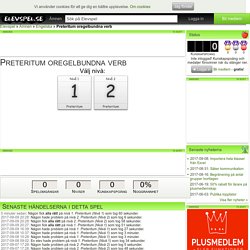
Preteritum (Nivå 1) som tog 60 sekunder. Preteritum på engelska. Past simple – regular verbs. The past simple is the most common way of talking about past events or states which have finished.
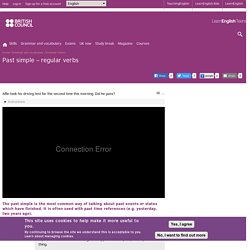
It is often used with past time references (e.g. yesterday, two years ago). Please explain past events or states! A past event could be one thing that happened in the past, or a repeated thing. I stopped at a zebra crossing. We carried on with the test. A state is a situation without an action happening. We stayed at my grandparents' house last summer. How do you form the past simple? Regular past simple forms are formed by adding -ed to the infinitive of the verb. start → startedkill → killedjump → jumped Yes, but there are some spelling rules. Agree → agreed like → liked escape → escaped If a verb ends in a vowel and a consonant, the consonant is usually doubled before -ed. stop → stopped plan → planned If a verb ends in consonant and -y, you take off the y and add -ied. try → tried carry → carried But if the word ends in a vowel and -y, you add -ed.
FREEBIEIHaveWhoHasGameIrregularVerbs-2ezi3i0-1zngwe6. Irregular Verbs Rap – Cringeworthy, but effective – The Canswedian English Te... This irregular verb rap by “Fluency MC” is lovely for many reasons.

You get to bust out your super embarrassing rap movesYou get to make your students bust out their super embarrassing rap moves It’s really a win win situation all around. Use this when you are teaching irregular verbs and past participles with your students. Also, when you feel like there are students who would benefit from a more musical approach to learning verbs. Songs and Activities for English Language Learners. Songs can be an effective way to introduce or reinforce a grammar topic.
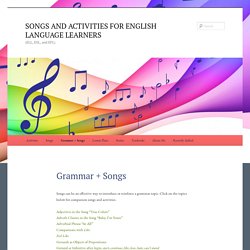
Click on the topics below for companion songs and activities. (In a blog article posted Oct. 4, 2016 at AzarGrammar.com, I list some of the benefits of using songs to teach grammar that I’ve observed in my own classroom.) Adjectives in the Song “True Colors”Adverb Clauses in the Song “Baby, I’m Yours”Comparisons with LikeFeel LikeGerunds as Objects of PrepositionsGerund or Infinitive after begin, start, continue, like, love, hate, can’t standGet to Do SomethingGotta: Informal Spoken English for Got ToInfinitives as AdjectivesI’ve Got It and I’ve Got ‘EmMust Have + Past ParticipleNoun ClausesParticipial PhrasesReflexive PronounsShould Have + Past ParticipleThird Person Singular: Mistakes in the Song “Memories” by Maroon 5Used to + a Verb in the Simple FormUsed to vs. English Language Learning Tips - Tenses Part 1. Kollaborativa samtal för fördjupad förståelse - en engagerande grammatiklekti... Grammatikens plats i språkundervisningen är omdebatterad och på vilket sätt den ska hanteras är inte helt enkelt.
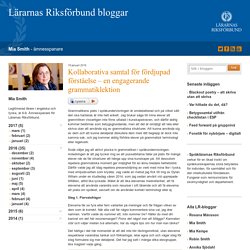
Jag brukar säga till mina elever att grammtiken visserligen inte finns uttalad i kunskapskraven, och därför aldrig kommer bedömas som betygsgrundande, men att det är omöjligt att tala eller skriva utan att använda sig av grammatiska strukturer. Att kunna använda sig av dem och att kunna detaljerat diskutera dem med rätt begrepp är dock inte samma sak, och jag kommer aldrig förhöra elever på grammatisk terminologi eller regelverk. Fonetik för nybörjare - digitalt - Mia Smith. Ett ämne som berörs av språklärare med jämna mellanrum är fonetisk skrift.

För ett antal år sedan var det en naturlig del av undervisningen, så ser det inte riktigt ut idag. Word Order - Kimstudies. English question words - Kimstudies. Perfect English Grammar. Question tags. Question tags Question tags are the short questions that we put on the end of sentences – particularly in spoken English.

There are lots of different question tags but the rules are not difficult to learn. Positive/negative If the main part of the sentence is positive, the question tag is negative …. He’s a doctor, isn’t he? ... and if the main part of the sentence is negative, the question tag is positive. You haven’t met him, have you? With auxiliary verbs The question tag uses the same verb as the main part of the sentence. They’ve gone away for a few days, haven’t they? Without auxiliary verbs If the main part of the sentence doesn’t have an auxiliary verb, the question tag uses an appropriate form of ‘do’.